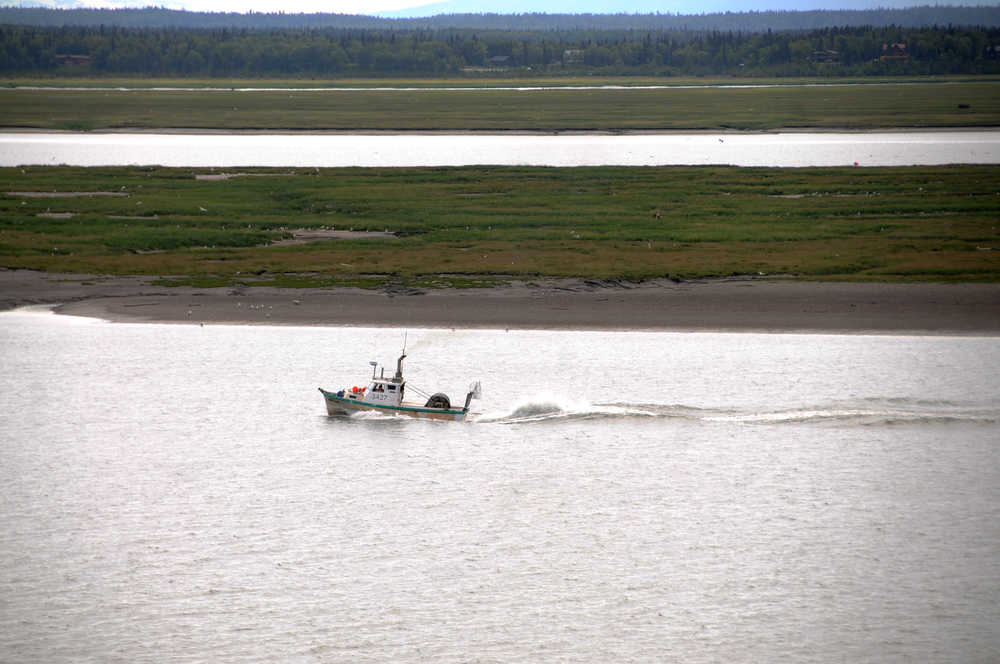Drift fishermen and setnetters in the Central District of Cook Inlet wet their gear for the first time last week, preparing for a large run of sockeye salmon to the Kenai River this year.
The Central District drift fleet got its first green light on June 20, heading out for a regular 12-hour period of fishing, hauling in 1,984 salmon, more than 94 percent of which were sockeye. The number of salmon hauled in increased to more than 3,000 during the next period on June 23, and nearly tripled from that on June 27, according to the Alaska Department of Fish and Game’s inseason harvest estimates. The drift boats headed out again for a regular period on Thursday.
Some setnets have been out periodically since May in the Northern District, targeting specifically king salmon in the area of Cook Inlet north of Boulder Point on the east side. The Northern District directed king salmon commercial fishery ended for the 2016 season with an approximate total catch of 2,042 kings and 2,239 sockeye, according to the Division of Commercial Fisheries’ inseason summary.
The Upper Subdistrict setnets in the Ninilchik, Cohoe and Kalifornsky South district went out June 23 and met with reasonable success, bringing in a few thousand fish each, also mostly sockeye with less than 100 kings between them on each day so far.
Most of the harvest this time of year is Kasilof sockeye salmon, and though the harvests are a little less than last year so far, they are relatively steady, said Division of Commercial Fisheries area management biologist Pat Shields.
“We haven’t had any slow days, we haven’t had any really big days,” Shields said. “Just a steady pull coming in.”
Erik Huebsch, a drift fisherman in the Central District, said the fishing season so far has been relatively normal, with about half the fishing fleet coming out in the last few periods.
“Last year across the whole state, the salmon were on the small size, undernourished, not looking really healthy,” Huebsch said. “This year, they’re healthier, they look normal, they’re acting normally.”
Management of the commercial setnet fishery will change after July 1, when the management emphasis switches to the late run of Kenai River king salmon. The projected run is greater than 22,500 fish, the trigger point for paired restrictions in both the setnet and inriver sport fisheries, but not much more, so the managers plan to begin the month conservatively, Shields said.
After July 1, east side setnetters’ two regular periods will remain, but the number of additional hours will be limited to 48. The inriver Kenai River sport fishery will be strictly no-bait from the mouth upstream to the outlet of Skilak Lake from July 1–31, according to a press release issued Friday from Fish and Game.
Shields said he did not expect managers to use all the hours available to the setnet fisheries until the escapement goals have been achieved. The bait closure and hour restriction is not a paired restriction because the run is projected to come in greater than 22,500, but the department is choosing to manage conservatively at the beginning of the season. Setnetters in the Kasilof Section of the Upper Subdistrict and drifters in the Kasilof Section got an additional period Satuday from 8 a.m. to 11 p.m., bringing the number of additional hours last week to 24.
“We’re just going to start out being careful and watching the daily passage of king salmon into the river,” Shields said.
Salmon prices are expected to recover somewhat this year after low prices impacted the salmon markets in Alaska last season. An algal bloom in Chile killed more than 25 million farmed salmon, pushing down the global supply of farmed Atlantic salmon down by 6 percent in 2016. Chilean coho production also decreased by 29 percent this year due to a red tide event, according to market update from the Alaska Seafood Marketing Institute.
Managers expect a run of 7.1 million sockeye to the Kenai River with a commercial harvest of 4.3 million fish, about 1.2 million more than the 10-year average, according to the Upper Cook Inlet 2016 outlook, published in March. Though the harvest is greater in the inlet than last year, across the state, harvests are expected to decrease, helping to bolster demand and thus prices, according to the Alaska Seafood Marketing Institute’s bulletin.
Huebsch said although the prediction is only a prediction, he is optimistic about the sockeye return to Upper Cook Inlet this year.
“I hope the runs come back in the strength that they’ve predicted,” he said. “If it does, it’ll be a good thing for everybody here. It’ll certainly be a good turn for the economy.”
Reach Elizabeth Earl at elizabeth.earl@peninsulaclarion.com.

